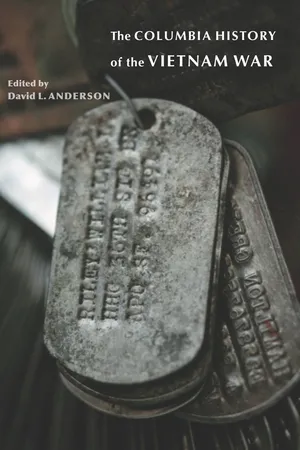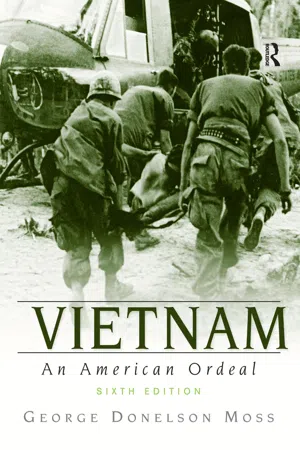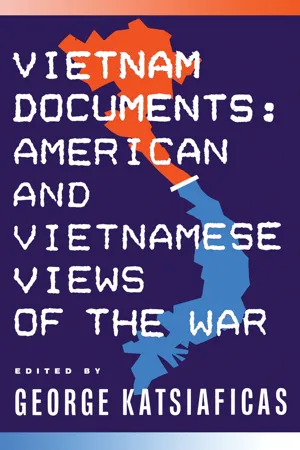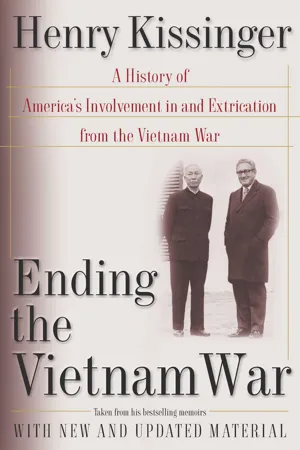History
Ending of The Vietnam War
The Vietnam War ended with the fall of Saigon on April 30, 1975, when North Vietnamese forces captured the city. This event marked the conclusion of the war and the reunification of Vietnam under communist control. The United States had withdrawn its troops in 1973, and the fall of Saigon signaled the defeat of South Vietnam and the end of the war.
Written by Perlego with AI-assistance
Related key terms
8 Key excerpts on "Ending of The Vietnam War"
- eBook - ePub
- David Anderson(Author)
- 2010(Publication Date)
- Columbia University Press(Publisher)
THE POSTWAR WARS IN SOUTHEAST ASIAThe Vietnam War was one of the major wars of the twentieth century. It lasted for thirty years in Vietnam, and for Americans it spanned twenty-five years, from the establishment of the U.S. Military Assistance Advisory Group in Vietnam in 1950 to the evacuation of the U.S. Embassy in Saigon in 1975. The estimate of Vietnamese deaths, military and civilian, is about 2 million, and millions more Vietnamese were wounded, missing, or rendered homeless. Villages, forests, and farms throughout the country were destroyed by high explosives, napalm, and defoliants. More than 58,000 Americans died, and 300,000 more were wounded. Direct U.S. government expenditures were about $140 billion, which added to the national debt, contributed to double-digit inflation by the 1970s, and took away resources needed for social services in the United States. Although the fighting in Vietnam ended in 1975, the high costs and long duration of the war had an enduring impact on the people and nations of Southeast Asia, on American veterans of the war, and on American politics, society, and culture. As with any major historical event, there was also the question of what lessons could be derived from all of this violence and sacrifice. Because the United States lost the war, coming to terms with its legacies and drawing conclusions from it have been difficult and divisive for Americans, and some issues remain highly contested. The American war in Iraq that began in 2003 raised again, in very real terms, a division over the meaning of the phrase “no more Vietnams.” Did the result of the American war in Vietnam mean that the United States should steer clear of direct intervention in deeply rooted local conflicts? Or should the United States never again enter into a war in which the American people and their leaders were not willing to use whatever power and take whatever time was necessary to achieve U.S. objectives?The Vietnam War was an internal conflict between rival Vietnamese factions, but it was always part of broader regional and international political upheavals that followed World War II. As the fighting was ending in Vietnam, it was also ending in the other former French protectorates of Laos and Cambodia. Following the signing of the Paris Peace Accords for Vietnam, the contending parties in Laos produced a similar document. The Communist Pathet Lao dominated the coalition created by this agreement and had close ties with the Vietnamese Communist Party. With Hanoi’s victory in 1975, the Pathet Lao took direct control of the government in Vientiane and began a concerted effort to kill all the Hmong minority who had fought with the CIA against the Laotian and Vietnamese Communists. Many Hmong died, but about 100,000 managed to escape to the United States. - eBook - ePub
- Loramy Gerstbauer(Author)
- 2016(Publication Date)
- Routledge(Publisher)
The Vietnam War was the most divisive period in the United States during the twentieth century. The war caused intense debate over national identity, calling into question the foundational myth of American exceptionalism, which portrays the United States as a pure, selfless, and nonimperial nation (Fry 2006, 175). The debate over Vietnam continues to affect U.S. foreign policy long after 1975, and the lessons of Vietnam were evoked in the Persian Gulf War, the 2003 Iraq war, and, as noted already, in Obama’s response to the Syria conflict in 2014.The Vietnam War extended beyond the nation of Vietnam into neighboring Laos and Cambodia. For the Vietnamese, the conflict also extended beyond the timeframe of U.S. involvement, which was from 1954–1973, heightening in 1965 with an air campaign and then ground troops. Although the Vietnam War involved different theaters in Southeast Asia, the focus of this analysis is on the relations between Vietnam and the U.S. only. The analysis also puts little emphasis on reconciliation between North and South Vietnam, except where it factors into U.S.-Vietnamese relations.A Cold War Proxy War
U.S. goals in the war must be perceived through the lens of the Cold War. The U.S. sought to reduce the threat of Sino-Soviet domination of Asia, to thwart “wars of national liberation” in developing nations, and to otherwise halt Communism and its threat to peace and stability in Asia. The U.S. also expressed a goal of promoting democracy and free trade and investment (Kenny 2002, 129). The fear of collapsing dominoes of Communism was real. John F. Kennedy cautioned that “Vietnam represents the cornerstone of the Free World in Southeast Asia, the keystone to the arch, the finger in the dike. Burma, Thailand, India, Japan, the Philippines, and obviously, Laos and Cambodia are among those whose security would be threatened if the red tide of Communism overflowed into Vietnam” (14). Likewise, President Lyndon Johnson viewed Vietnam through the lens of the Communist tide. He justified his 1965 decision to send troops into South Vietnam in terms of a “Jakarta-Hanoi-Beijing-Pyongyang axis, with Cambodia probably to be brought in as a junior partner and Laos to be merely absorbed by the North Vietnamese and the Chinese” (117). The war was also viewed as a defense of South Vietnam against the aggression of Communist North Vietnam. According to President Johnson, “Our purpose in Vietnam is to prevent the success of aggression. It is not conquest; it is not empire; it is not foreign bases; it is not domination. It is, simply put, just to prevent the forceful conquest of South Vietnam by North Vietnam” (14). The degree to which the war can be understood as one of northern aggression is still debated. To what degree was there genuine rebellion in South Vietnam, with South Vietnamese Communists rebelling against the South Vietnamese government, and to what degree was North Vietnam controlling these entities in the South such that the conflict was more of a North/South Vietnamese conflict? (Nguyen 2006). - eBook - ePub
The Vietnam War
A Study in the Making of American Policy
- Michael P. Sullivan(Author)
- 2021(Publication Date)
- The University Press of Kentucky(Publisher)
None of these large-scale perspectives is meant to explain the specific occurrence of the Vietnam War, when it occurred, or when it ended. Rather, these perspectives are an attempt to step back and put some envelopes around the Vietnam War and America’s involvement in order to bring to bear the broadest possible perspective.THE VIETNAM WAR AND THE COLD WAR
One generally and popularly accepted explanation of the United States’ involvement in the Vietnam War is that it flowed from the larger Cold War pitting the two largest and most powerful nations coming out of World War II against each other. While the bipolarity that emerged in the late 1940s and early 1950s was later to fade, during much of that crucial period a popular interpretation of world politics pitted the socialist, atheist, Eastern-bloc countries against the capitalist, religiously oriented, Western countries. Although it was not a complete split (the United States even provided aid to some Eastern European, Communist-bloc countries) still the political rhetoric and popular perception at the time was of a highly bipolarized world.It is interesting, then, to see exactly how the Vietnam War fits within that broader context of the East-West struggle. A brief historical review shows the Cold War to be not one single, static entity, but rather a changing, dynamic, fluctuating, interaction process. The six-year period from 1946 to 1952 was a relatively “hot” period in East-West relations, including the Russian takeover of Eastern Europe, the Berlin crisis of 1948, the formation of NATO, the Marshall Plan, and the outbreak of the Korean War. This was followed by a period of relative détente, from about 1953 to perhaps 1956, with the occurrence of the stalemate and then the cease-fire of the Korean War in 1953, the 1954 Geneva Conference to consider a settlement to the Vietnam situation, the Geneva summit of 1955, and the so-called Spirit of Camp David. The next hot period lasted from about 1956 to about 1963, and included the Russian invasion of Hungary in 1956, the downing of an American U-2 in Russia and the subsequent cancellation of the 1960 summit meeting, the Bay of Pigs, Kennedy’s bellicose speech following his summit meeting with Khrushchev in 1961, erection of the Berlin Wall of 1961, and finally the Cuban Missile Crisis of late 1962. The one exception during this period was 1959, when there was much-heralded talk of détente between East and West, which, of course, was followed by the breakup of the planned 1960 summit meeting between Premier Khrushchev and President Eisenhower because of the Russian downing of the American U-2 spy plane. - eBook - ePub
Vietnam
An American Ordeal
- George Donelson Moss(Author)
- 2016(Publication Date)
- Routledge(Publisher)
On April 23, speaking to a large audience at the Tulane University field house, President Ford made U.S. abandonment of South Vietnam official. He urged Americans to forget about the Vietnam War and avoid arguments about who was to blame for its disastrous outcome. He told the crowd:America can regain the sense of pride that existed before Vietnam. But it cannot be achieved by refighting a war that is finished as far as America is concerned.36As Ford uttered the magic word, “finished,” the predominantly student audience of 4,500 erupted with frenzied whistling, cheering, clapping, foot-stomping, and shouting that lasted for several minutes. The president had given voice to the national mood existing at the moment the PAVN forces readied themselves to win the final victory of the long Vietnam War.THE FALL OF SAIGON , APRIL 27-30, 1975As the Communists drove relentlessly toward their final triumph during the last days of April 1975, the contrast in the national mood with what it had been nearly ten years earlier when President Johnson had sent U.S. armed forces off to fight a land war in Southeast Asia could not have been greater. That combination of pride, arrogance, innocence, crusading anti-Communism and expectations of a quick and easy triumph that had propelled the country into the war had long vanished. During those woeful final days, the national mood was dominated by an overwhelming desire to be rid at last of an endless war. It was a war that had already cost far more in lives and dollars than any worst-case scenarist could have imagined at its outset. A nation that had been badly divided by political and cultural crises exacerbated by the nation’s longest war wanted only for the war to cease. As the Saigon government, which the United States had helped create and sustained for over 20 years, suffered its death agonies at the end of April 1975, most Americans averted their eyes.The North Vietnamese and VietCong had the city by the throat; their tanks and artillery were ready and their troops were positioned for attack. But for a few days they held back to allow the Americans and those Vietnamese who had worked for U.S. officials to leave. Within the doomed city, thousands of Vietnamese tried desperately to escape. Everywhere, Americans were accosted by Vietnamese brandishing letters and documents, pleading for a way out of their country. To facilitate the evacuation of South Vietnamese nationals, the U.S. Congress hastily approved legislation waiving entry restrictions for 150,000 Indochinese aliens, including 50,000 high-risk Vietnamese. Each day, thousands of Vietnamese flew out of Tan Son Nhut Airport onboard C-141s and C-130s that formed a round-the-clock airlift to freedom. - eBook - ePub
Vietnam
Explaining America's Lost War
- Gary R. Hess(Author)
- 2015(Publication Date)
- Wiley-Blackwell(Publisher)
1 From the Streets to the Books: The Origins of an Enduring DebateFrom its beginning, the Vietnam War divided Americans. In the summer of 1965, President Lyndon Johnson made an open-ended military commitment to the defense of South Vietnam. It came after several months of a mounting crisis that left the beleaguered South Vietnamese government and its army on the verge of collapse in the face of a communist insurgency. Limited application of American military power had failed to halt the political-military deterioration. Earlier in 1965, Johnson had launched a bombing campaign against North Vietnam, which supported the Viet Cong insurgents and had sent American combat troops, beginning with some 3,500 marines. Despite the acceleration of the bombing and an increase of troops to 40,000 men, American officials recognized by July, 1965 that a much larger military commitment was the only means of saving South Vietnam from a communist takeover. Despite Johnson’s effort to downplay the magnitude of his decision, Americans recognized that it meant that tens of thousands of additional troops soon would be sent to Vietnam and that indeed the nation was at war.While most Americans supported Johnson’s decision, going to war in Vietnam was met with less enthusiasm than other wars. About 60 percent of the public thought the military commitment was correct, but one-fourth of them thought it was a “mistake,” while the remainder of people were uncertain. In another opinion poll in which Americans were asked which course of action should be followed – hold the line, negotiate and get out, carry the war to North Vietnam – not even a majority, only 48 percent, favored the first alternative that reflected the position of Johnson, while 31 percent supported “negotiations and get out” (barely 17 percent favored the more aggressive third alternative, and 4 percent were undecided). This hesitancy on the part of Americans contrasted sharply with their attitudes toward other recent wars: when Harry S. Truman sent US troops to fight in Korea in 1950, when George H. W. Bush launched war in the Persian Gulf in 1991, and when George W. Bush began the war to overthrow Saddam Hussein in 2003, at least three-fourths of the public in each case approved of their decisions.1 - eBook - ePub
The Cold War and After
Capitalism, Revolution and Superpower Politics
- Richard Saull(Author)
- 2007(Publication Date)
- Pluto Press(Publisher)
Peace talks, then, continually stalled, interrupted by periods of intense US bombing and communist military offensives such as in the spring of 1972, until negotiations resumed in the summer of 1972 that led to the peace agreement in January 1973 signed by all four parties: North and South Vietnam, the US and the NLF. 35 With the passing of the War Powers Resolution in November 1973, combined with the Watergate scandal, Nixon’s promise of rescuing the south should Hanoi breach the peace agreement unravelled, and with the Saigon government refusing to act on the stipulations of the agreement on negotiations to bring the NLF into government, Hanoi decided to use military force to break the impasse in the spring of 1975, culminating in North Vietnamese troops capturing Saigon on 25 April 1975 and bringing the Vietnam War to an end. The fall of Saigon was quickly followed by the fall of the other Indochinese dominoes to communist forces in 1975. Yet wider south-east Asia and the key state of Indonesia remained resolutely anti-communist. The US had lost Vietnam but had made North Vietnam and the Vietnamese people pay a dreadful price to secure national and social liberation. A number of factors contributed to the US defeat. The anti-war movement in the US, assisted – as the Republican right would have it – by a ‘treacherous liberal media’, and the reassertion of Congressional authority over foreign policy and executive power, all played a significant role in the US ‘losing the war on the home front’. The role of the communist powers in supporting Hanoi and the Vietnamese people in their struggle were also crucial factors; the provision of aid and the deterrent to a full-scale US invasion of the north or use of nuclear weapons. 36 However, the key to the US defeat was local and based on the character of the two political forms that emerged from the first Vietnam War in 1954 - eBook - ePub
Vietnam Documents: American and Vietnamese Views
American and Vietnamese Views
- George Katsiaficas(Author)
- 2016(Publication Date)
- Routledge(Publisher)
Despite the massive destruction aimed at the guerrillas and the supply or arms to the Thieu regime, after the withdrawal of American ground troops it was only a matter of time before Saigon's army was defeated. When the southern regime finally collapsed in 1975, it occurred much more rapidly than anyone, including the North Vietnamese, had expected. Six months after the Paris peace treaty was signed, Congress had voted to cut funds for all American military operations in Indochina, and while hundreds of millions of dollars were allocated to the Thieu government, corruption and inefficiency severely limited that government's capabilities. In the context of rapidly advancing North Vietnamese and PRG armed forces, it appeared that the overthrow of the Thieu government was imminent. Henry Kissinger, then secretary of state, appealed to Congress (Document 43) on April 15, 1975, for hundreds of millions of dollars in emergency aid for the government of South Vietnam. Congress never took action on his request, and two weeks later Saigon fell.The final document in this chapter, "Joys and Sorrows," was written by Truong Nhu Tang, a former treasurer of the NLF who played a prominent role in the new government of South Vietnam after the war. He eventually became a "boat person," leaving Vietnam surreptitiously and making his way to Paris. Few people had been better placed to judge how the northerners who came south after the war treated their southern compatriots. Tang's account conveys well the bittersweet character the 1975 victory has had for many NLF members.33 Vietnamization Will Shorten the War
Richard M. NixonSource: Richard M. Nixon, speech delivered on national television, November 3, 1969.Fifteen years ago North Vietnam, with the logistical support of Communist China and the Soviet Union, launched a campaign to impose a Communist government on South Vietnam by instigating and supporting a revolution.In response to the request of the government of South Vietnam, President Eisenhower sent economic aid and military equipment to assist the people of South Vietnam in their efforts to prevent a Communist takeover. Seven years ago, President Kennedy sent 16,000 military personnel to Vietnam as combat advisors. Four years ago, President Johnson sent American combat forces to South Vietnam. . . .For these reasons, I rejected the recommendation that I should end the war by immediately withdrawing all our forces. I chose instead to change American policy on both the negotiating front and the battlefront. . . .Obstacle to Peace
It has become clear that the obstacle in negotiating an end to the war is not the President of the United States. And it is not the South Vietnamese.The obstacle is the other side's absolute refusal to show the least willingness to join us in seeking a just peace. It will not do so while it is convinced that all it has to do is to wait for our next concession, and the next until it gets everything it wants. - eBook - ePub
Ending the Vietnam War
A History of America's Involvement in and Extrication from the Vietnam War
- Henry Kissinger(Author)
- 2003(Publication Date)
- Touchstone(Publisher)
14
The End of Vietnam
T hose who thought that the agony of Cambodia might inure them to the pain of South Vietnam’s collapse soon learned better. The tragic end of two decades of American sacrifice, dedication, and national division proved beyond getting used to.On March 10, the North Vietnamese, no longer even pretending to be bound by the Paris Agreement, launched a major offensive in the Central Highlands using divisions recently introduced from the North. They overran the strategic junction of Ban Me Thuot in two days, cutting all the roads from Saigon to the Central Highlands except for one very poor road constantly being harassed by Vietcong guerrillas.While the Central Highlands were tottering, Foreign Minister Tran Van Lam was sent by President Thieu to Washington to plead for the supplemental aid package. He reported to Saigon that there was no hope of obtaining any additional aid from the sitting Congress. Fear turned into certainty when the House and Senate Democratic caucuses (then the majority in Congress) voted overwhelmingly on March 12 and 13 against any further aid to South Vietnam.Thieu understood that, with his shrinking resources, he would no longer be able to defend the entire territory of his besieged country and ordered a strategic withdrawal from the Central Highlands. At the same time, he redeployed the 1st Airborne Division from the northern border to the area around Danang—both moves to start a few days hence, on March 16. Thieu’s intent was to create a defensible redoubt which might be held until a perhaps more sympathetic Congress was elected in 1976.As a war college exercise, Thieu’s move made good sense. In terms of Vietnamese realities, it ushered in catastrophe. Launched without preparation or detailed guidance from the Joint General Staff in Saigon, the “strategic withdrawal” had to be carried out over a single road—Route 7B—in bad repair and heavily mined. A major engineering job would have been required to make it usable, including the rebuilding of several collapsed bridges—tasks for which the South Vietnamese divisions were inadequately equipped. In addition to the combat units, Route 7B would have to accommodate a horde of fleeing civilians, for the dependents of the Army of the Republic of Vietnam divisions were always billeted close to the fighting units—in this case, in Pleiku, the capital of the Central Highlands. As soon as word of the withdrawal order filtered down, panic set in, and a mass exodus followed. To compound the chaos, the regional militias, composed mostly of local tribes called Montagnards, rioted upon hearing that they were to be left behind.
Learn about this page
Index pages curate the most relevant extracts from our library of academic textbooks. They’ve been created using an in-house natural language model (NLM), each adding context and meaning to key research topics.







